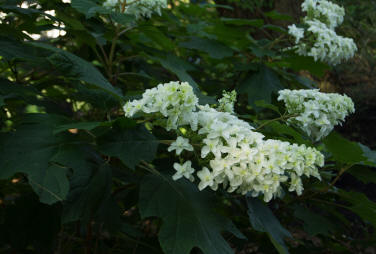
(5/31) Shrubs play an essential role in a garden because they provide a long-term commitment of enjoyment to the gardener and observer. The attributes of a shrub that will be a vital compliment to your landscape are their flower appearance, long bloom life, remarkable foliage, and ease of maintenance. Oakleaf Hydrangea (Hydrangea quercifolia) meets
all the requirements for an amazing shrub selection for your garden.
Oakleaf Hydrangea is one of our most beautiful native woody perennial species in the United States and naturally grows along the riverbanks and woodlands of the Southeast. Large clusters of flowers fully covered by sepals and strong sturdy stems that hold the vividly-colored flowers above the foliage make this a delightful selection for your garden
landscape. The Ruby Slippers variety (and this author’s favorite) is a semi-compact cultivar that dazzles with deep-red blooms in mid-summer. It has resistance to root-rot diseases. The Queen of Hearts selection boasts enormous flower spikes that fade from white to a rose-blush color. It is a late-bloomer, so its flowers remain vibrant in the landscape at least two weeks
longer than those of most other cultivars. Planting cultivars with diverse bloom times lengthens the overall flowering span, and late-blooming cultivars may help flowers avoid late-spring freezes in cold areas.
 The broad, dark green leaves are oak-shaped, giving the plant its name. They make an attractive backdrop for other plants. The leaves are largest on plants grown in the shade. This shrub can reach from 6 to 8 feet high and wide.
The broad, dark green leaves are oak-shaped, giving the plant its name. They make an attractive backdrop for other plants. The leaves are largest on plants grown in the shade. This shrub can reach from 6 to 8 feet high and wide.
An Oakleaf Hydrangea is a very adaptable shrub because it can take full sun or shade. However, for the best flowers and fall colors plant in full sun. It likes moderate water, but after it has been established it can tolerate drought. This versatile shrub is a beauty throughout the year. In the spring and summer it shows off tall, striking flowers
and various hues of foliage. In autumn, it displays deep reddish-purple leaves and dried flower heads that last into early winter. On mature Oakleaf Hydrangeas, the bark often peels to reveal a rich, dark brown layer, which is attractive in the winter.
All Hydrangeas make good dried flowers, and Oakleafs are no exception. Cut and dry them for year-round arrangements.
If pruning is necessary, that should occur after it flowers, otherwise you will remove the flower buds. This shrub is hardy in USDA Zones 6-9 and prefers a thick winter mulching or a burlap wrap.
Oakleaf Hydrangeas are nearly problem-free from disease and pests. They will perform best if planted in a fertile, well-drained soil, but they will also tolerate other conditions. Pick a spot that has partial to almost full shade. Be sure to give it plenty of room to expand. Provide water until the plant is established. After that it will require
little irrigation or other maintenance, aside from watering during extended dry periods or pruning occasionally to maintain its form.
A gardener will make a wise selection when choosing an Oakleaf Hydrangea. It is native to the United States, cold tolerant, drought tolerant, and showcases beautiful flowers, foliage, and bark. If you desire a shrub in your landscape that will attract attention three seasons of the year, consider planting an Oakleaf Hydrangea.
Read other articles on plants and gardens
Read other articles by Carolyn Black